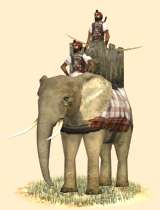Elephantes Hulaioi Liboukoi (African Forest Elephants)
 |
Weapons | Defence | Mental | ||||||
|---|---|---|---|---|---|---|---|---|---|
| Primary | Secondary | Armour: | 14 | Morale: | 8 | ||||
| Type: | none | none | Shield: | 0 | Discipline: | normal | |||
| Attack: | 4 | 5 | Skill: | 8 | Training: | trained | |||
| Charge: | 0 | 50 | Recruitment | Other | |||||
| Lethality: | 1 | 0.2 | Soldiers: | 6 | Hit Points: | 1 | |||
| Range: | 160 | 0 | Cost: | 10000 | Mass: | 1 | |||
| Ammo: | 30 | 0 | Upkeep: | 2500 | |||||
| Turns: | 2 | ||||||||

Imported from the regions far south of Aigyptos or from the mountain forests of northwestern Africa, Forest Elephants are an exceptionally valuable resource in combat, used mainly by the Ptolemaioi and Qarthadastim.
Can Run Amok
Frightens Infantry
Imported from the regions far south of Aigyptos or from the mountain forests of northwestern Africa, forest elephants are an exceptionally valuable resource in combat, used mainly by the Ptolemaioi and Qarthadastim. Towering over most other creatures, they can easily scare men and horses alike, with both their size and smell, though elaborate bells and trappings often add to their intimidation. Such corps are directed by their own mahouts riding behind their heads, often a native of their own country who has spent at least two years training his beast from capture. The mahout is armored to better protect against the obvious assault that generally comes against him, launched to bypass the thick natural armor of his mount.
Elephants are best used as cavalry screens for your army, where their presence can scare away enemy cavalry. They can also be used to ram through an enemy battle line, though they are less useful when faced with loose order or phalanx infantry. Pyrrhos of Epeiros even innovated a tactic of flank screens when he fought the Romans at Heraklea. Beyond their obvious use against enemy infantry or cavalry, they can also be used in siege combat; battering down gates, though they're highly vulnerable to better prepared installations. Their greatest vulnerability is against skirmishers, slingers and archers, who can pepper them with missiles - eventually toppling them by virtue of their cumulative impact. To counter the effect of enemy skirmishers, it is often wise to array your own in opposition, or to maintain constant attacks upon each individual group.
Historically, the use of elephants in war was largely contained to India, but after the battle of Hydaspes that changed. Though Alexandros never cared over much for the animals, his successors were very much in favor of their use, organizing their own elephants into a distinct corps under their own "elephantarchos". The forest elephant was used in battle after the Ptolemaioi dynasty established itself in Egypt. Being cut off from India by their Seleukid rivals, the Ptolemaioi needed another source of elephants and sent expeditions to the Horn of Africa to gather Forest Elephants and later they established “elephant stations” to make sure the Ptolemaic armies were well supplied.
Qarthadastim also used forest elephants in war and they seem to have begun using them around 300 BC. The forest elephants were captured in the Tunisian mountain forests, but the Carthaginians also imported elephants from the Seleukeis and Ptolemaioi, which might indicate the native herds were not enough to supply the Carthaginian elephant corps.
The Forest Elephant was smaller in size and strength compared to the Indian elephant. The battle of Raphia is often used as an example of the Indian elephant’s superiority, as Antiochus III elephants routed Ptolemaios IV elephants, yet it’s important to remember that Ptolemaios IV elephants were outnumbered at that battle.
A side effect of the Ptolemaic use of elephants caused the kingdom of Meroe to also start to tame and use elephants during the Hellenistic period, a practice they eventually taught to the Ethiopians as well. The forest elephants could be found in north-western & eastern Africa, but after the Romans conquered north-western Africa they hunted the forest elephant there to extinction due to their love for using them in circus and the arenas.
Despite their great usefulness when properly employed, it was not unusual for elephants to cause defeat for those who employed them. If an enemy was clever enough to devise their own means to combat elephants, as was the case at the battle of Gaza when Ptolemaios planted an ‘iron spiked minefield’ to ward off elephants, or when Caesar properly utilized slingers and Scipio gaps between his infantry cohorts to channel the elephants, they could be defeated and even turned against their masters. Even pigs were used on occasion, released among elephants who were often scared of their comparatively small, darting forms. However, despite the many different weapons and stratagems being devised to fight them and the huge expenses required to maintain them, the elephant was still considered a valuable asset, maintained widely. The Arche Seleukeia even developed a corps of "elephant guards", whose task was simply to defend the beasts in combat.